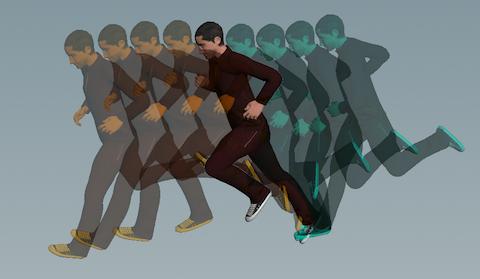| On this page |
Onion skinning is a viewport visualization for animation that displays an animated object at multiple frames. The current frame is displayed normally and the other animation frames, or 'onion skins', are displayed as partially transparent ghosts. By showing the object across multiple frames, the artist can get a sense of its movement.

Onion skinning is enabled on a Geometry object using the Onion Skinning menu in the Misc tab. The number of frames displayed, frame step, and skin opacity can all be set in the Viewport tab of the 3D Display Options .
Enable Onion Skinning ¶
Onion skinning can be enabled on a Geometry object by setting the Onion Skinning parameter to Transform Only or Full Deformation.
Transform Only
The geometry from the current frame is used, while the object transform is animated. This is faster than Full Deformation if the underlying geometry changes over time.
Full Deformation
The geometry is recooked at each frame along with the object transform.
Onion skinning can also be globally disabled by toggling off the Onion Skinning toggle in the menu of , in the right viewport toolbar. Turning on the global onion skinning display option will restore onion skinning for those objects that have it enabled.
Note
Onion skinning is not shown on ghosted objects. If an object has onion skinning enabled and a different object is entered to the SOP level, the onion skinning will be disabled.
Onion Skinning Options ¶
There are several display options related to onion skinning in the Viewport tab of the 3D Display Options . They allow you to change:
-
The number of skins before and after the current frame.
-
The frame increment between skins.
-
The tinting of skins before and skins after, independently.
-
The opacity of the skins, from 0 to 100%.
Increasing the number of skins displayed will adversely affect playback performance, especially if Full Deformation mode is used.
Onion Skinning Tips ¶
-
Only use onion skinning on one or a few objects at a time. The performance hit can make scrubbing and playback slow.
-
If the deformation of the geometry is minimal, try Transform Only to improve performance.
-
Reducing the number of skins can also improve performance.
-
For slowly moving animations, increase the Frame Step display option to more easily see the animation. Similarly, fast animations can be better visualized with a small Frame Step.
-
Adjusting the skin opacity can help in situations where the skins are very crowded. This can be done in the Viewport tab of the 3D Display Options .